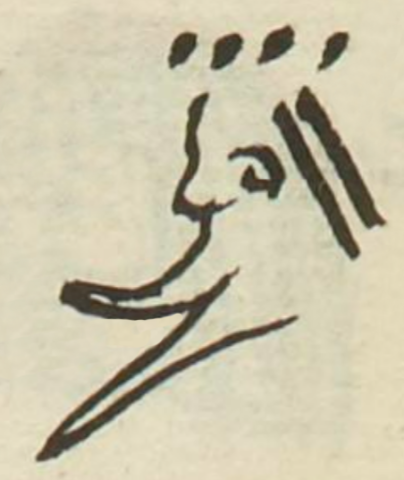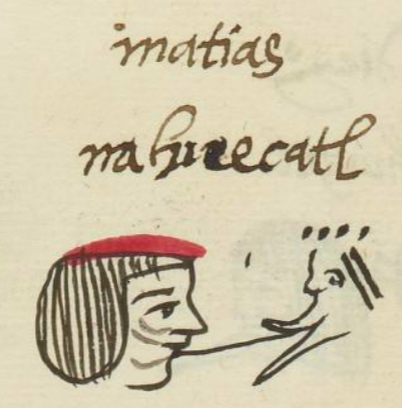Nahui Ecatl (MH507r)
This black-line drawing of the compound glyph for the personal name "Four Air/Breath" (Nahui Ecatl) or "Four Wind" (Nahui Ehecatl) is attested here as a man’s name. It shows four dots running horizontally above the head of a figure in profile, facing toward the viewer's left. The mouth has the shape of a beak (which Nahuas seem to have perceived rather as a blowing device). The visible eye is open. Two vertical black lines appear on the edge of the face. Because this is obviously a day name with a notation from the calendar, and so Ehecatl was probably meant over Ecatl for this person's name.
Stephanie Wood
Gabrielle Vail and Christine Hernández (Re-Creating Primordial Time, 2013, ) describe Ehecatl as the wind aspect of Quetzalcoatl, and they note that Ehecatl "wears a buccal (duck) mask through which to blow wind." That the "beak" may have been perceived as a blowing device is supported by the glyph for Pitztli (below).
The gloss gives "Ecatl," but the visuals suggest "Ehecatl." A great many glyphs in this collection start with Eca- when one might expect Eheca-. We are preserving the proclivity of the gloss for Eca-, while also pointing to the likelihood of an unintentional oral abbreviation of Eheca- to Eca-.
Wind (ehecatl) was a day sign in the 260-day divinatory calendar called the tonalpohualli. Calendrics plays an important role in Nahuas' religious views of the cosmos.
The black line (face paint?) across this man's face has yet to be analyzed fully, but in this manuscript at least, it is a diagnostic feature of Ehecatl.
Stephanie Wood
matias nahuiecatl
Matías Nahui Ehecatl
Stephanie Wood
1560
Jeff Haskett-Wood and Stephanie Wood
viento, wind, deities, deidades, fuerzas divinas, divine forces, números, numbers, ones, unos

nahui, four, https://nahuatl.wired-humanities.org/content/nahui
eheca(tl), wind, breeze, movement of the air, https://nahuatl.wired-humanities.org/content/ehecatl
eca(tl), breath, air, https://nahuatl.wired-humanities.org/content/ecatl
Cuatro Viento, o 4-Viento
Stephanie Wood
Matrícula de Huexotzinco, folio 507r, World Digital Library, https://www.loc.gov/resource/gdcwdl.wdl_15282/?sp=93&st=image
This manuscript is hosted by the Library of Congress and the World Digital Library; used here with the Creative Commons, “Attribution-NonCommercial-ShareAlike 3.0 License” (CC-BY-NC-SAq 3.0).






